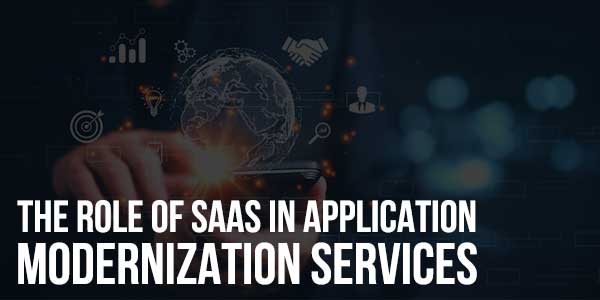
The digital landscape is rapidly transforming and businesses are looking to evolve quickly to meet the changing customer demands. This is where the application modernization services are playing a vital role in bringing the paradigm shift. Also, you must remember that Software-as-a-Service (SaaS) is another game-changer, fueling this transformation. SaaS is the best way through which your application can increase scalability, enhance agility, and you can minimize operational costs. Therefore, you can consider SaaS as an indispensable component of modern application development strategy.
Here, in this article, we are going to discuss the role of software-as-a-service in application and software modernization, highlighting the core advantages, implementation strategies, and best practices to build and achieve modern applications, offering seamless performance.
Table of Contents
What Is Application Modernization Services?
If you have to define application modernization in simple words, it is a process of upgrading your legacy and outdated software with the latest version of the app and ensuring that the platform aligns seamlessly with your specific business requirements, technological trends, and user expectations.
While modernizing and updating your legacy applications, you may have to migrate them to the cloud, re-architect their infrastructure or architecture, or integrate them with the latest technologies, including artificial intelligence, the Internet of Things, microservices, and other platforms. The primary aim of modernizing your application is to enhance its functionality, and performance, ensure end-to-end compatibility, and robust security.
If you are still using outdated systems, you must have noticed that your organization tends to face various challenges, including errors during development, delays in delivering projects, higher maintenance costs, and inability to scale applications as desired. The only way to mitigate all these issues and inefficiencies is to choose software modernization that offers innovative solutions, which are fast, reliable, and can be customized according to your business requirements.
The Emergence Of SaaS In Application Modernization:
SaaS is revolutionizing processes and transforming how businesses operate. They are advanced cloud-powered solutions that help you reduce overall costs by eliminating the need for on-premise infrastructure. SaaS solutions are off-the-shelf software that are ready-to-use systems, accessible from any device with an internet connection.
The three main pillars of SaaS applications are scalability, agility, and flexibility. Hence, you can regard SaaS as the best companion for your business and modern applications as it addresses all your pain points, including prolonged development cycles, high maintenance costs, and customization.
The Core Benefits Of SaaS In Application Modernization:
Cost-Effectiveness:
As we have discussed earlier, when you build and deploy a SaaS application, you do not have to invest anything additional on hardware, and website servers, and also bury all your worry of regular maintenance. This is mainly because SaaS offers you the preferred ‘Pay-as-You-Go’ Model to reduce your costs significantly. You also do not have to spend on updating the software, upgrading the security patches, and saving on other upfront costs.
Higher Scalability and Flexibility:
Whether it is the demand of modern-day customers or the market trends, it keeps changing and fluctuating, requiring businesses to remain scalable and flexible to meet expectations. You will be happy to note that SaaS is playing this role with perfection by allowing organizations to scale resources up or down smoothly. It means that you can manage increased workloads efficiently without facing performance bottlenecks.
Enhanced Agility:
SaaS also makes the application deployment process faster and smoother, allowing you to accelerate time-to-market for new features and services. Being agile means your business is ready to embrace innovation and stay ahead of the competition. It also empowers your development team to experiment with integrating new features, tools, and technologies without long-term commitments.
Improved Security and Compliance:
The companies providing application modernization services also focus on implementing advanced security measures and tools to ensure data protection and compliance with global regulations. Thus, you can enable your client’s business to pay more attention to its growth prospects without thinking about regulatory risks and other vulnerabilities. Incorporating features like data encryption, automatic backups, multi-factor authentication, and user access control helps you adhere to the latest industry standards and comply with GDPR and HIPPA to increase platform security.
Continuous Updates:
One of the specific reasons why you must look to modernize your application with SaaS is that you will receive regular updates from the software development company at frequent intervals. These updates include addition of the new features, performance enhancements, and security updates. This means your application remains always up-to-date and bug-free, amplifying the user experience and engagement levels.

Viable SaaS Strategies To Modernize Applications:
Cloud Migration:
One of the most important and best result-oriented strategies is migrating legacy systems to SaaS platforms hosted in the cloud. By doing so, you can minimize dependency on the old infrastructure and increase the application’s accessibility and performance. Also, cloud migration ensures robust data security, easy and quick availability, and disaster recovery capabilities. Cloud migration has become almost indispensable for businesses with distributed teams.
Implementing Microservices Architecture:
Almost all SaaS software seamlessly integrates with microservices. It means that you can move your business from monolithic architecture to smaller and more manageable microservices architecture components. The biggest advantage of adopting microservices is simplifying maintenance and enabling independent updates. You can also adopt the ‘best-of-breed’ approach to integrate tailored tools fitting into the needs.
Integration With DevOps Practices:
SaaS platforms and applications are powered by DevOps methodologies that automate pipeline deployment and enable continuous integration and continuous delivery (CI/CD). This means that you can improve the speed of application development and deliver projects before the stipulated deadline. DevOps also enhances software reliability and indeed fosters better collaboration between the development and operations teams, accelerating modernization efforts.
Using APIs for Interoperability:
Modern applications require seamless interaction between systems. SaaS-based solutions often come with strong APIs, and businesses can integrate these different applications to streamline processes to enhance operational productivity. One can also use APIs to make on-premise systems interact with SaaS solutions for a hybrid system when needed.
Challenges And Solutions In SaaS-Based Modernization:
Data Migration Complexities:
Moving your data from an outdated system to a SaaS platform can be a complicated and challenging process, especially if you have to migrate large datasets or sensitive information.
The best solution to tackle this issue is to use data migration tools and hire experienced service providers to ensure a safe and efficient migration. Also, you must emphasize cleansing and validating data to avoid any errors during the migration process.
Vendor Lock-In:
Leaning heavily on a particular SaaS vendor is not the right approach and advice as it may land you into areas of uncertainty and various difficulties. This becomes more probable if the software company changes its pricing model or discontinues or removes some of its features.
The solution to this problem is choosing SaaS vendors that support open standards and integrate multi-cloud strategies so that you do not have to depend on a single SaaS provider. Diversification of providers also ensures continuous services.
Customization Constraint:
SaaS platforms probably do not offer extensive levels of customization that traditional software solutions provide.
Solution: Opt for SaaS providers that offer modular solutions or APIs, allowing for greater customization. Partner with SaaS vendors to customize features to suit your unique requirements whenever feasible.
Regulatory and Compliances Issues:
Global organizations often face the challenge of complying with complex regulatory requirements while integrating SaaS platforms and solutions.
If we talk about its effective solution, you must collaborate with SaaS providers with a proven track record in compliance and data sovereignty. Also, ensure they define their service-level agreements (SLAs) explicitly with compliance requirements.
Conclusion:
If you want to unleash the true and full potential of application modernization services, you must look to follow the best practices, such as accessing the business needs, selecting the right SaaS vendor, planning for incremental modernization, and monitoring the application performance regularly.
SaaS application modernization has empowered businesses to shun the limits of traditional legacy systems, achieve cost savings, and enhance greater scalability, and agility. There are a few challenges, but modern-day developers are trying their best to address them and ensure a seamless transition.

 About the Author:
About the Author:
















Be the first to write a comment.